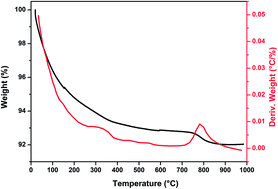Aqueous-phase catalytic hydroxylation of phenol with H2O2 by using a copper incorporated apatite nanocatalyst
Abstract
Copper incorporated apatite (Cu-apatite) nanomaterial was prepared by a co-precipitation method. The obtained material was characterized by thermogravimetric analysis (TGA), X-ray diffraction (XRD), X-ray photoelectron spectroscopy (XPS), Fourier transform infrared (FT-IR) and Raman spectroscopy, scanning electron microscopy (SEM, STEM) and nitrogen adsorption–desorption. The as-prepared Cu-apatite was used to catalyze phenol hydroxylation with hydrogen peroxide as an oxidant. The influencing parameters including reaction time, temperature, H2O2/phenol ratio and catalyst mass have been investigated. Under the optimized conditions, the Cu-apatite catalyst gave a phenol conversion of 64% with 95% selectivity to dihydroxybenzenes. More importantly, the results of catalyst recycling indicated that the same catalytic performance has been obtained after four cycles with a slight loss of activity and selectivity.



 Please wait while we load your content...
Please wait while we load your content...